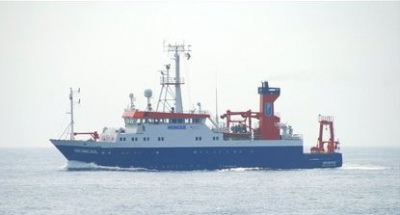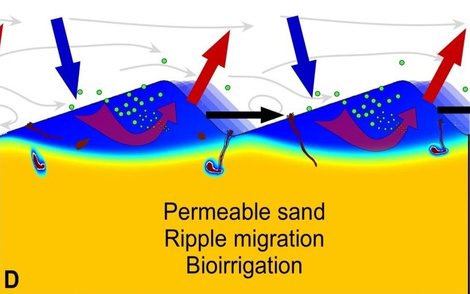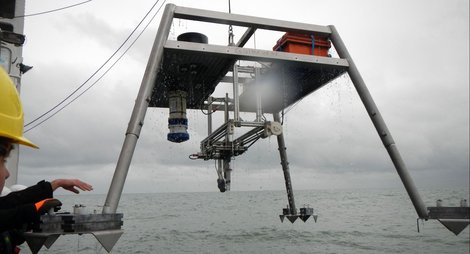Die Inhalte dieser Seite sind leider nicht auf Deutsch verfügbar.
Seitenpfad:
- Coastal Dynamics
- Expeditions
- HE 432
HE 432
HE 432
Vessel: RV Heincke
Dates: 13.9. (Bremerhaven) to 27.9.2014 (Bremerhaven)
Area: German Bight
Involved Projects: MARUM CCP5 / SD1
PI: Moritz Holtappels (MARUM, MPI)
Participants: Moritz Holtappels (MARUM/MPI), Christian Winter (MARUM), Jana Friedrich (HZG), Ulrike Schückel (Senckenberg), Volker Meyer (MPI), Soeren Ahmerkamp (MPI), David Proband (MPI), Kerry Latham (MPI), Gabriel Herbst (MARUM), Christian Ferreira (MARUM), Knut Krämer (MARUM), Celine Naderipour (HZG)
This cruise will visit different sedimentary domains in the German Bight. Ship based hydro-acoustic mapping and sampling of the sea bed and water column will be combined with autonomous lander deployments.
The aim of the research cruise is to understand the dynamic exchange of nutrients and oxygen between the sediment and the water column. The exchange of these solutes depends on bottom water currents and the composition and topography of the sediment (Figure 1). The sandy sediment of the North Sea is relatively coarse and even small pressure gradients allow for an advective flow in its pore space, which speeds up the exchange between bottom water and pore water supplying a very active microbial community in the sediment. The temporal variability of currents and the related sediment transport, such as the formation and migration of dunes and ripples, create a very dynamic pore water flow and very dynamic redox conditions. Neither the regulation of microbial processes nor their turnover per area is well understood and measured under these conditions, despite the fact that up to 70% of the coastal areas on earth consist of this kind of sediments.
By applying benthic Landers for high resolution measurements of bottom water hydrodynamics, seabed topography, oxygen penetration depth and benthic oxygen uptake we seek to understand the interaction between permeable sediments, hydrodynamics and the resulting advective porewater transport (Figure 2). Stations with different sediment properties, water depths and water column nutrient concentrations will be investigated to estimate the range of boundary conditions that allow enhanced microbial turnover rates. The bathymetry and sea floor structure of different areas are mapped with a ship based multibeam echo sounder (Figure 3) and parametric echo sounder and seafloor samples are taken for on board and later laboratory analyses. On board experiments will focus on the microbial activity and its adaptation to highly variable redox conditions induced by the dynamic porewater flow.
Dates: 13.9. (Bremerhaven) to 27.9.2014 (Bremerhaven)
Area: German Bight
Involved Projects: MARUM CCP5 / SD1
PI: Moritz Holtappels (MARUM, MPI)
Participants: Moritz Holtappels (MARUM/MPI), Christian Winter (MARUM), Jana Friedrich (HZG), Ulrike Schückel (Senckenberg), Volker Meyer (MPI), Soeren Ahmerkamp (MPI), David Proband (MPI), Kerry Latham (MPI), Gabriel Herbst (MARUM), Christian Ferreira (MARUM), Knut Krämer (MARUM), Celine Naderipour (HZG)
This cruise will visit different sedimentary domains in the German Bight. Ship based hydro-acoustic mapping and sampling of the sea bed and water column will be combined with autonomous lander deployments.
The aim of the research cruise is to understand the dynamic exchange of nutrients and oxygen between the sediment and the water column. The exchange of these solutes depends on bottom water currents and the composition and topography of the sediment (Figure 1). The sandy sediment of the North Sea is relatively coarse and even small pressure gradients allow for an advective flow in its pore space, which speeds up the exchange between bottom water and pore water supplying a very active microbial community in the sediment. The temporal variability of currents and the related sediment transport, such as the formation and migration of dunes and ripples, create a very dynamic pore water flow and very dynamic redox conditions. Neither the regulation of microbial processes nor their turnover per area is well understood and measured under these conditions, despite the fact that up to 70% of the coastal areas on earth consist of this kind of sediments.
By applying benthic Landers for high resolution measurements of bottom water hydrodynamics, seabed topography, oxygen penetration depth and benthic oxygen uptake we seek to understand the interaction between permeable sediments, hydrodynamics and the resulting advective porewater transport (Figure 2). Stations with different sediment properties, water depths and water column nutrient concentrations will be investigated to estimate the range of boundary conditions that allow enhanced microbial turnover rates. The bathymetry and sea floor structure of different areas are mapped with a ship based multibeam echo sounder (Figure 3) and parametric echo sounder and seafloor samples are taken for on board and later laboratory analyses. On board experiments will focus on the microbial activity and its adaptation to highly variable redox conditions induced by the dynamic porewater flow.

RV Heincke

The sandy seabed as a high throughput bioreactor. Bottom water flow across sediment ripples creates pressure gradients that drive porewater flow in permeable sediments. Oxygen (blue) and organic matter (green dots) such as algae are rapidly transported into the sediment, where the organic matter is mineralized. In turn, the produced nutrients (red) are released back into the water column to supply the algae growth.

A benthic Lander for autonomous measurements over a tidal cycle. The Lander simultaneously measures current velocity, seabed topography and oxygen penetration depth.


